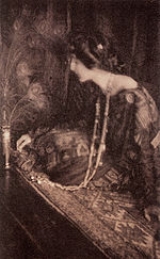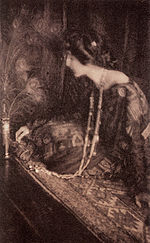
Joseph Keiley
Encyclopedia
Joseph Turner Keiley was an early 20th century photographer, writer and art critic. He was a close associate of photographer Alfred Stieglitz
and was one of the founding members of the Photo-Secession
. Over the course of his life Keiley's photographs were exhibited in more than two dozen international exhibitions, and he achieved international acclaim for both his artistic style and his writing.
 He went to school in New York and became an attorney, founding the Manhattan law firm of Keiley & Haviland. He began photographing in the mid-1890s and met fellow New York photographer Gertrude Käsebier
He went to school in New York and became an attorney, founding the Manhattan law firm of Keiley & Haviland. He began photographing in the mid-1890s and met fellow New York photographer Gertrude Käsebier
, who at that time was engaged in photographing American Indians who were performing in Buffalo Bill's Wild West Show. Keiley also photographed some of the same subjects, and in 1898 nine of his prints were exhibited in the Philadelphia Photographic Salon.
One of the judges for the Salon was Stieglitz, who also wrote a glowing review of Keiley's work.
Due to his success in Philadelphia the next year Keiley became the fourth American elected to the Linked Ring, which at that time was the most prominent photographic society in the world promoting pictorialism
.
In 1900 he joined the Camera Club of New York and had a one-person exhibition in the Club's gallery. At that time Stieglitz was serving as the Vice President of the Club and editor of the Club's journal Camera Notes
, and Keiley soon became his closest ally. Stieglitz asked him to become Associate Editor of the journal, and over the next few years Keiley was one of its most prolific writers, contributing articles on aesthetics, exhibition reviews and technical articles. He also had several of his photographs published in the journal.
While working with Stieglitz the two began experimenting with a new printing technique for glycerine-developed platinum prints, and they co-authored an article on the subject that was later published in Camera Notes.
In 1902 Stieglitz included Keiley as one of the founding members of the Photo-Secession
, and he had fifteen of his prints (one more than Edward Steichen
) included in the inaugural exhibition of the Photo-Secession at the National Arts Club
.
When Stieglitz started Camera Work
in 1903 he asked Keiley to become Associate Editor, and for the next eleven years he was second only to Stieglitz in the details of publishing the journal. He contributed dozens of essays, reviews and technical articles, and he advised Stieglitz about promising new photographers from Europe.
Keiley had seven gravures published in Camera Work, one in 1903 and six in 1907.
Later in his life he traveled to Europe and Mexico, and he spent several years trying to seat a radical friend, in a peaceful coup, as President of Mexico.
In 1914 Keiley died of Bright's Disease
. Stieglitz wrote a long eulogy for his friend in Camera Work, and he kept Keiley's name on the masthead of the journal until it ceased publication in 1917.
Alfred Stieglitz
Alfred Stieglitz was an American photographer and modern art promoter who was instrumental over his fifty-year career in making photography an accepted art form...
and was one of the founding members of the Photo-Secession
Photo-Secession
The Photo-Secession was an early 20th century movement that promoted photography as a fine art in general and photographic pictorialism in particular. A group of photographers, led by Alfred Stieglitz and F...
. Over the course of his life Keiley's photographs were exhibited in more than two dozen international exhibitions, and he achieved international acclaim for both his artistic style and his writing.
Life
Keiley was born in Maryland, the eldest of seven children born to John D. and Ellen Keiley. The family moved soon after his birth to Brooklyn, New York, where he grew up. Little is known about his childhood.
Gertrude Käsebier
Gertrude Käsebier was one of the most influential American photographers of the early 20th century. She was known for her evocative images of motherhood, her powerful portraits of Native Americans and her promotion of photography as a career for women.-Early life :Käsebier was born Gertrude...
, who at that time was engaged in photographing American Indians who were performing in Buffalo Bill's Wild West Show. Keiley also photographed some of the same subjects, and in 1898 nine of his prints were exhibited in the Philadelphia Photographic Salon.
One of the judges for the Salon was Stieglitz, who also wrote a glowing review of Keiley's work.
Due to his success in Philadelphia the next year Keiley became the fourth American elected to the Linked Ring, which at that time was the most prominent photographic society in the world promoting pictorialism
Pictorialism
Pictorialism is the name given to a photographic movement in vogue from around 1885 following the widespread introduction of the dry-plate process. It reached its height in the early years of the 20th century, and declined rapidly after 1914 after the widespread emergence of Modernism...
.
In 1900 he joined the Camera Club of New York and had a one-person exhibition in the Club's gallery. At that time Stieglitz was serving as the Vice President of the Club and editor of the Club's journal Camera Notes
Camera Notes
Camera Notes was a photographic journal published by the Camera Club of New York from 1897 to 1903. It was edited for most of that time by photographer Alfred Stieglitz and was considered the most significant American photography journal of its time...
, and Keiley soon became his closest ally. Stieglitz asked him to become Associate Editor of the journal, and over the next few years Keiley was one of its most prolific writers, contributing articles on aesthetics, exhibition reviews and technical articles. He also had several of his photographs published in the journal.
While working with Stieglitz the two began experimenting with a new printing technique for glycerine-developed platinum prints, and they co-authored an article on the subject that was later published in Camera Notes.
In 1902 Stieglitz included Keiley as one of the founding members of the Photo-Secession
Photo-Secession
The Photo-Secession was an early 20th century movement that promoted photography as a fine art in general and photographic pictorialism in particular. A group of photographers, led by Alfred Stieglitz and F...
, and he had fifteen of his prints (one more than Edward Steichen
Edward Steichen
Edward J. Steichen was an American photographer, painter, and art gallery and museum curator. He was the most frequently featured photographer in Alfred Stieglitz' groundbreaking magazine Camera Work during its run from 1903 to 1917. Steichen also contributed the logo design and a custom typeface...
) included in the inaugural exhibition of the Photo-Secession at the National Arts Club
National Arts Club
The National Arts Club is a private club in Gramercy Park, New York City, New York, USA. It was founded in 1898 to "stimulate, foster, and promote public interest in the arts and to educate the American people in the fine arts". Since 1906 the organization has occupied the Samuel J...
.
When Stieglitz started Camera Work
Camera Work
Camera Work was a quarterly photographic journal published by Alfred Stieglitz from 1903 to 1917. It is known for its many high-quality photogravures by some of the most important photographers in the world and its editorial purpose to establish photography as a fine art...
in 1903 he asked Keiley to become Associate Editor, and for the next eleven years he was second only to Stieglitz in the details of publishing the journal. He contributed dozens of essays, reviews and technical articles, and he advised Stieglitz about promising new photographers from Europe.
Keiley had seven gravures published in Camera Work, one in 1903 and six in 1907.
Later in his life he traveled to Europe and Mexico, and he spent several years trying to seat a radical friend, in a peaceful coup, as President of Mexico.
In 1914 Keiley died of Bright's Disease
Bright's disease
Bright's disease is a historical classification of kidney diseases that would be described in modern medicine as acute or chronic nephritis. The term is no longer used, as diseases are now classified according to their more fully understood causes....
. Stieglitz wrote a long eulogy for his friend in Camera Work, and he kept Keiley's name on the masthead of the journal until it ceased publication in 1917.

